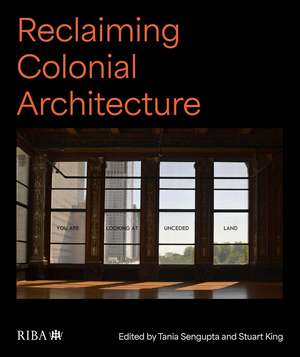Reclaiming Colonial Architecture
Editat de Tania Sengupta, Stuart Kingen Limba Engleză Hardback – dec 2024
Offering historical background, unpacking key concepts and presenting thematically organised and multi-scalar urban and architectural case studies, this accessible publication showcases how legacies of colonialism are being dealt with in real-world instances. Case studies involve works and actions by built environment professionals such as architects and heritage practitioners, as well as community initiatives and activism.
The book aims to build confidence in practitioners, students and communities grappling with a seemingly vast and complex terrain of debates and approaches around colonial landscapes, urban areas, buildings, monuments and material culture. It also aims to be a helpful resource for architecture schools or critical heritage studies departments and organisations. Its content will provide a point of departure for graduate student inquiry and its accessible nature will help introduce undergraduate students to the concepts and questions of colonial built-environments.
Preț: 354.98 lei
Nou
Puncte Express: 532
Preț estimativ în valută:
67.92€ • 70.92$ • 56.09£
67.92€ • 70.92$ • 56.09£
Carte disponibilă
Livrare economică 25 martie-08 aprilie
Livrare express 11-15 martie pentru 53.83 lei
Preluare comenzi: 021 569.72.76
Specificații
ISBN-13: 9781915722362
ISBN-10: 1915722365
Pagini: 224
Dimensiuni: 210 x 250 x 20 mm
Greutate: 1 kg
Ediția:1
Editura: Riba Publishing
Colecția RIBA Publishing
ISBN-10: 1915722365
Pagini: 224
Dimensiuni: 210 x 250 x 20 mm
Greutate: 1 kg
Ediția:1
Editura: Riba Publishing
Colecția RIBA Publishing
Public țintă
Professional Practice & DevelopmentCuprins
Acknowledgements Introduction: Reclaiming Colonial Architecture - Critical Practices of Lands, Cities, Buildings and Artefacts by Tania Sengupta and Stuart King Lands * L1 - Truth Telling at Wybalenna (Flinders Island, Australia) * L2 - Inga Ancestral Inhabitation Knowledge Mapping (Andean Amazon, Colombia) by Pedro Jajoy, Jhon Tisoy, Musu Jacanamijoy, Juliana Ramírez and Catalina Mejía Moreno * L3 - Ma Joie, Plantation House (Mahé, Seychelles) by Helénè Frichot * L4 - The Counter Plantation of Barbados (St George, Barbados) by Mackenzie Luke * L5 - Watery Archives, Aqueous Methods (Manchester, England) by Huda Tayob * L6 - The Inscrutable Mire: Designing with Other-than-Human Agency (Banff, Canada) by Tiffany Kaewen Dang * L7 - Reclaiming the Landscape Beyond the Highway (Jerusalem) by Mira Idries Cities * C1 - Postcolonial Anxiety and Fragmented Revitalisation of Jakarta’s Old Town (Jakarta, Indonesia) by Amanda Achmadi * C2 - Making, Un-making and Re-making Colonial Space, New Delhi (Delhi, India) by Arunava Dasgupta * C3 - Contesting Pasts: (Re)Interpretating Contested Colonial Pasts in Harbin (Harbin, China) by Wenzhuo Zhang * C4 - Dangerous Heritage in Danger: Colonial-Imperial (Neo)classicism of the Ukrainian South (Odesa, Ukraine) by Ievgeniia \'Jenia\' Gubkina * C5 - Two Missing Colonial Monuments in Germany (Hamburg and Berlin, Germany) by Valentina Rozas-Krause * C6 - ReOrientalism : The Ramadan Pavilion at the Victoria and Albert Museum (London, UK) by Shaheed Saleem Buildings * B1 - The Chicago Cultural Center and the Settler Colonial City (Chicago, USA) by Andrew Herscher and Ana-Maria León * B2 - Rainbow Serpent (Version) at the Martin-Gropius-Bau (Berlin, Germany) by Michael Mossman and Andrew Leach * B3 - Decolonising Fascist Colonial Legacy, Demodernising Architecture (Borgo, Sicily) by Emilio Distretti and Alessandro Petti * B4 - The Claude Bernard Hospital in Paris: a Debris of Empire (Paris, France) by Guillaume Lachenal, Gaëtan Thomas, Simon De Nys-Ketels and Johan Lagae * B5 - Rescripting The Invisible City (Johannesburg, South Africa) by Althea Peacock and Tanzeem Razak * B6 - Reconnecting Architecture with Country in the Redfern Community Facility (Sydney, Australia) by Aileen Sage Architects and Daniele Hromek * B7 - (Re-)inhabiting the Junta Dos Bairros e Casas Populares Neighbourhoods (Maputo, Beira & Nampula, Mozambique) by Patricia Noormahomed * B8 - The Paradox of Andean Colonial Temples in Arica and Parinacota (Arica and Parinacota, Chile) by Magdalena Pereira and Cristian Heinsen * B9 - Coral White: Reclaiming (?) Missionary Architecture in the Cook Islands (Rarotonga and Mangaia, Cook Islands) by Jeanette Budgett, Carolyn Hill and Jean Mason * B11 - Dissonant Heritage: The Loss of the Apia Courthouse (Apia, Samoa) by Christoph Schnoor Things * T1 - Spring Bay Mill: A Place to Gather Again (Triabunna, Australia) by Ross Brewin * T2 - Interpreting and Communicating Taiwan’s Colonial Industrial Heritage (Taiwan) by An-Yu Cheng and Ping-Sheng Wu * T3 - Re-weaving, Re-building: The Malkha Cotton Factory (Ellanthakunta (Telengana), India) by Tania Sengupta * T4 - Now You See It, Now You Don’t: The Henry Jarvis Memorial Hall Screen, 66 Portland Place (London, UK) by Neal Sashore * T5 - Toppling Crowther: Activists, Institutions and Colonial Monuments (Nipaluna/Hobart, Australia) by Stuart King * T6 - The Lobi Vessel: A New Practice for the Architecture of Afrorevivalism (Lobi Country, Western Africa) by Richard Adetokunbo Aina * T5 - Harmful Objects (Beloved Subjects): Colonial Family Archives (County Down, Northern Ireland) by Briony Widdis Conclusion: Architectures of Critical and Responsive Practice by Tania Sengupta and Stuart King Editor bios Contributor bios Affiliated organisations References Index Image Credits
Notă biografică
Dr Tania Sengupta teaches and is Director of Architectural History and Theory at the Bartlett School of Architecture, University College London.
Dr Stuart King is a Senior Lecturer in Architectural Design and History, and Program Coordinator for the Master of Urban and Cultural Heritage at the University of Melbourne, Australia.
Dr Stuart King is a Senior Lecturer in Architectural Design and History, and Program Coordinator for the Master of Urban and Cultural Heritage at the University of Melbourne, Australia.
Descriere
Our world is full of lands, cities, buildings and artefacts, many of which are deposits and residues of colonial times and, more pervasively, colonial processes. Reclaiming Colonial Architecture unpacks the built inheritances of colonialism and re-thinks how we might understand, narrate, intervene in or act upon them as architects.
